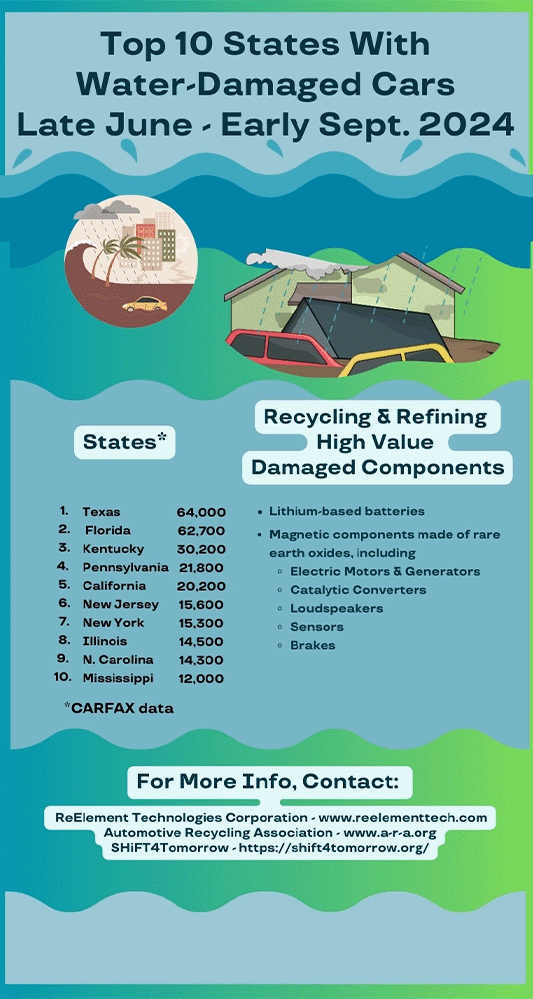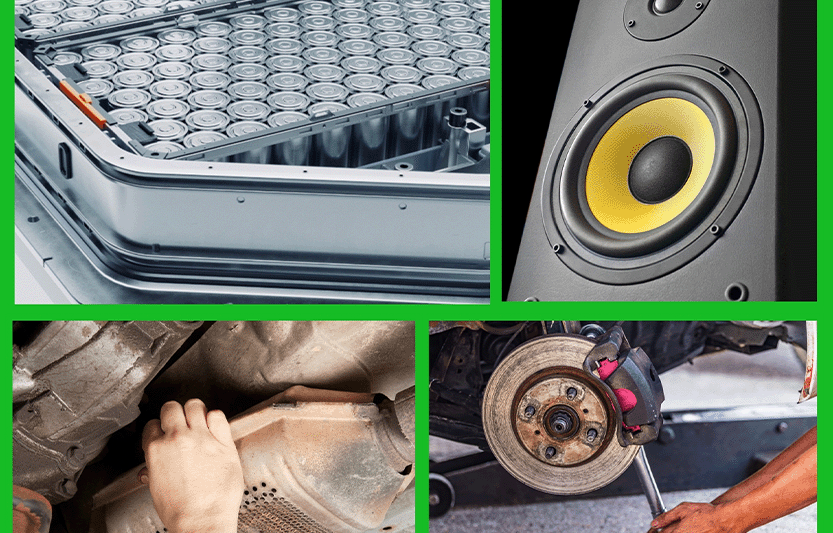
ungvar | stock.adobe.com
Water is the mortal enemy of any electrical system. Floodwater is a special concern for any vehicle’s electronics and electrical systems even if it was submerged for only a short time.
In the aftermath of Hurricanes Helene and Milton, and smaller storms during the summer, including in California, people ask what impact these storms will have on the destroyed cars, trucks and buses, and what it means for recyclers.

Carfax estimates that as many as 347,000 vehicles were flood-damaged between late June and late October, covering most of this year's hurricane season.
Hurricane Helene’s deluge damaged 138,000 vehicles across Florida, Georgia, Virginia, Tennessee, North Carolina and South Carolina. Then, Hurricane Milton damaged as many as 120,000 vehicles in Florida. Up to 89,000 vehicles were hit with water damage from smaller storms during the summer.
The value of damaged vehicles sent to scrapyards or used car lots goes well beyond common replacement parts such as hubcaps, doors or hoods. The real treasure lies in the critical minerals and rare earth elements used in components that power our vehicles.
The overwhelming volume of damaged cars has vehicle recyclers asking, “How can we extract the valuable components and derive cash value for car owners, communities, insurers and manufacturers?”
Components pass through many hands on their journey from salvage to recycling, from the tow truck, to disassembly, to sorting and evaluation and then to being purified into critical minerals and rare earths ready for manufacture into new products.
Several national organizations serve the automotive recycling community up and down the supply chain. On a national scale, the Automotive Recyclers Association (ARA), Manassas, Virginia, and the Shift Vehicle Retirement Initiative are two such groups actively engaged with communities on this issue.
We at ReElement Technologies Corp. are ready to help individuals and families in the South and other regions put their lives and livelihoods back together since the hurricanes. For the vehicle recycling industry in particular, our team is working to alleviate a challenging and important part of the recycling process facing salvage companies, especially in treating chemically complex metals like rare earth elements.

Technologies Corp.
When working with salvage companies, the first thing we do is collaborate with them and our partners to remove the end-of-life components containing either lithium batteries or permanent magnets.
After these specific components are removed, we run them through size reduction and heat treatment preprocessing steps to concentrate the nonferrous minerals such as lithium, nickel and cobalt or the rare earth elements.
After this standard preprocessing, we run the concentrates through our patented refining process exclusively licensed from Purdue University.
The process uses metallic binding resin to purify and separate the rare-earth elements or critical battery minerals.
Finally, the critical minerals and rare earths are returned to industry to manufacture new products.
This generates a good deal of economic activity, including jobs, for the circular economy.
Critical minerals such as lithium, cobalt, nickel and manganese, and rare earth magnet-grade materials, such as neodymium, dysprosium and praseodymium, are widely used across the transportation industry. Today’s high-tech vehicles contain permanent magnets made from rare earths and are essential to electric vehicle (EV) motors and generators, brakes, sensors, stereo speakers and other parts. Once recycled and refined, they are transformed into magnet-grade rare earth oxides to be manufactured into new permanent magnets. Lithium, which has become the poster child for critical minerals in EV batteries, can be purified and separated from recycled batteries into lithium carbonate ready to be manufactured into new battery cathodes.
Recycling helps reduce the need for imported feedstock and finished products from foreign entities. Modern, domestic refining techniques provide superior environmental benefits by keeping hazardous materials out of landfills, reducing smelting and reducing the need for new mining, among other benefits.
Rare earths also are used in catalytic converters, UV cut glass and polishing powder and LCD screens. Permanent magnets are even used in the manufacturing production line to hold up heavy parts such as doors awaiting installation.
Addressing the problem
National and local organizations are responding to this year’s storms.
“The members of the Automotive Recyclers Association and the industry as a whole are beginning to see the residual effects from Hurricanes Helene and Milton,” says ARA President Eric Wilbert. "The unfortunate timing and location of Milton hitting the same area within a few weeks caused delays in claims being processed from Helene. These flooded vehicles that have been deemed a total loss are beginning to appear at salvage auctions.
“The tens of thousands of anticipated vehicles will undoubtedly find their way into the hands of the professional automotive recyclers. While each vehicle is evaluated case by case, many of these vehicles still hold significant economic and environmental value. By recycling undamaged parts to be resold to the collision repair industry, as well as directly to consumers, the auto recycling industry strengthens its position as a carbon-negative industry. The members of the ARA are proud stewards of our environment and look forward to responsibly recycling many of the vehicles damaged by these hurricanes."
Shift also helps consumers and companies recycle vehicles with environmentally responsible protocols from start to finish. “In the wake of tragic catastrophic weather events, not all is lost for families with heavily water-damaged vehicles,” says Shift Director Chapin Griffith.
“A long-standing and robust vehicle recycling industry in the U.S. maximizes recovered value from totaled vehicles, helping insurance companies continue compensating families fairly on claims, or providing families top dollar for their scrap vehicle direct from recycling center,” Griffith adds. "In turn, recycling provides critical raw materials back to the supply chain, promoting a circular economy. Furthermore, the Shift Vehicle Retirement Initiative extracts unique value from totaled vehicles by committing them to be fully retired from the road, explicitly counting the impact of carbon avoidance and net reduction from older, less efficient engines."
Sponsored Content
Still relying on manual sorters?
Let AI do the heavy lifting. Waste Robotics delivers reliable, high-performance robots tailored for complex waste streams. They require minimal maintenance, are easy to operate, and are designed to boost your recovery rates. Smarter sorting starts with the right partner. Waste Expo Booth #1969 & REMA #2843
Click here to see our robots in action!Value proposition
Recycling valuable vehicle components is a solution that serves companies and workers throughout the supply chain: those who disassemble the vehicles, those who collect the components and those who process them into highly purified metals for the manufacturing supply chain.
Take lithium, one of the critical minerals used in hybrid and EV batteries. Lithium prices have fluctuated dramatically over the past couple of years, but data has shown the price of lithium carbonate to be around $6,000-$10,000 per metric ton. A standard EV contains around 0.005 to 0.015 metric tons of lithium carbonate, according to estimates made by the U.S. Department of Energy. Multiply that by 300,000 vehicles, for example, and one can see the value recovered by recycling.

and a catalytic converter, which all contain critical metals or rare
earths that can be recycled.
Rare earths such as neodymium and dysprosium are essential to the manufacture of very powerful permanent magnets used in hybrids and EV components. It is widely known that China has a near monopoly over the production of rare earth minerals, which are essential for most of today’s advanced technologies. An October story in the New York Times pointed to China’s growing power over rare earths, reporting that “China’s refineries produce 99.9 percent of the world’s dysprosium.” Because it is highly heat resistant, it is used as an additive in powerful magnets for electric cars. Today it sells for more than $100 per pound, according to the report.
The Rare Earth Industry Association, citing forecasts from Argus Media, shows continued demand for neodymium and dysprosium, as well as other rare earths, as far into the future as 2033 for a number of applications. The New York Times article also cited an International Energy Agency prediction that clean energy industries like wind turbines and EVs would need seven times as many rare earths in 2040 as they needed in 2020.
These forecasts point to increased demand for rare earths over the next decade. For that reason, I am confident that recycling vehicle components containing rare earths and critical minerals can benefit recyclers, vehicle owners, insurers and manufacturers by stabilizing domestic supply chains and the laws of supply and demand.
Next steps
One should not sugarcoat the high cost of flood damage to vehicle owners or communities. Yet, Americans' resilient spirit always finds a way to recover and help each other. Recycling damaged vehicles gives us an opportunity to reclaim valuable resources to keep our circular economy moving forward.
Mark Jensen is chairman and CEO of Fishers, Indiana-based ReElement Technologies Corp. and American Resources Corp. and chairman at Land Betterment Corp. ReElement is a multifeedstock, multimineral refiner for the electrification economy, national defense purposes and the mobility market. For more information, visit www.reelementtech.com
Get curated news on YOUR industry.
Enter your email to receive our newsletters.
Latest from Recycling Today
- Steelmakers await impact of tariff policy
- Radius loses money, says merger on track
- Electrostatic technology vies for role in ASR sorting
- ReMA board to consider changes to residential dual-, single-stream MRF specifications
- Trump’s ‘liberation day’ results in retaliatory tariffs
- Commentary: Waste, CPG industries must lean into data to make sustainable packaging a reality
- DPI acquires Concept Plastics Co.
- Stadler develops second Republic Services Polymer Center









